Abstract
Innovation and sustainability have become dynamic tools to foster success in rural tourism. However, the effects of the two concepts in rural tourism have been largely overlooked. Hence, it seems timely to present a quantitative survey of the literature in these topics. Based on 94 articles published in the Scopus database, we found that innovation and sustainability in rural tourism is mostly a European concern, with the bulk of the articles published in the last ten years. China, Italy, and Spain are the main countries under analysis and the Sustainability Journal is the major outlet for dissemination of knowledge. This study can serve as a strategic guide for researchers, policymakers and entrepreneurs in the sector, supporting evidence-based decision-making. It has sought to understand the evolution of the existing literature on sustainable and innovative rural tourism; it has identified the most influential researchers and research centers that can promote future collaborations; and it has identified approaches and trends that are shaping the future of sustainable rural tourism. However, given the potential for innovation and sustainability towards rural tourism success, particularly in less developed and undeveloped countries, more research that ties all these three topics together is imperative.
1. Introduction
According to the United Nations’ World Tourism Organization (UNWTO) definition, rural tourism is ‘a type of tourism activity in which the visitor’s experience is related to a wide variety of products and services, often related to nature based activities (such as agriculture and forest), rural lifestyle and culture, rural heritage and sightseeing’ [1,2].
Innovation and sustainability are critical to the growth and success of rural tourism, as they help create resilient, thriving communities by imparting economic and social benefits, while preserving the natural and cultural resources that attract tourists. These concepts are important not only in the present but also in the future; they are undoubtedly considered as new triggers and drivers for tourism to position itself competitively in the market [3].
Innovation and sustainability are even more important in the context of scarce human and financial resources, typical of rural areas [4,5]. Indeed, by introducing new technologies, creative activities, and unique and traditional experiences, innovation improves the attractiveness of rural destinations [6] and enhances visitor experience [7]. This can include digital marketing, virtual tours, or eco-friendly and traditional lodging options, helping to attract a wider range of visitors who want an immersive and different experience in the rural space. Additionally, innovative approaches help small rural businesses, such as agricultural farms, to grow by creating niche markets, improving product offerings, and allowing them to diversify their agricultural activity [8,9]. In turn, sustainability in rural areas reinforces the conduct of managing rural tourism activities in ways that protect the environment, preserve local culture, and contribute to the economic and social well-being of local communities. By focusing on long-term benefits rather than short-term gains, sustainable rural practices can provide positive impacts for both tourists and rural communities.
Despite the importance of these concepts, the relationship between innovation and sustainability in rural tourism has been understudied and many studies focus only on a particular perspective—innovation or sustainability. Moreover, to the best of our knowledge, a quantitative bibliometrically based survey has not been conducted on this matter. The present study, therefore, fills a critical gap in the need for an extensive and systematic bibliometric study covering the role and impact of innovation and sustainability in rural tourism. It aims to provide guidelines for future studies by identifying new and current perspectives and challenges for strengthening innovative and sustainable approaches in rural tourism. With this objective in mind, the following specific objectives are identified: to develop a bibliometric analysis that includes the articles published in Scopus on the topic under analysis and to identify the main authors working on these themes, the geographical distribution of the studies, the connections between authors, the works most cited, the main media used for publication, the main topics, the main methodologies used and the main countries under analysis.
The paper consists of five parts. Following the Introduction, an overview of the ideas of innovation and sustainability in rural tourism is given in Section 2. The methodological approach is explained in Section 3, while Section 4 shows and discusses the results of the bibliometric exercise. The study’s primary contributions are outlined, its shortcomings are noted, and potential directions for further research are proposed in the conclusion (Section 5).
2. Literature Review
2.1. The Meaning of Rural Tourism
Rural tourism (RT) is not a new phenomenon in the tourism sector or in scientific research [10]. Its visibility increased at the end of the 1980s because of the negative impacts, mainly environmental and social, of what is known as ‘mass tourism’ [4]. As an alternative form of tourism, it is more consistent with the natural and social values of the countryside, allowing rural hosts and tourists to enjoy fruitful interaction and a more authentic experience [4,11,12].
A universal definition of RT lacks consensus [10,13,14,15,16]. This is because it includes different activities, such as agro-tourism, green tourism and village tourism [17,18] and varies between regions and countries [14,19,20]. As Rosalina et al. [10] claim, all this complexity has implications for the planning, management and performance of the activity and the territory in which it takes place. Lane [14] suggests that, in its purest form, rural tourism should have the following five characteristics:
- Located in a rural space.
- Functionally rural—built upon the rural world’s special features of small-scale businesses, open space, contact with nature and the natural world, heritage, ‘traditional’ societies and ‘traditional’ culture.
- Rural in scale—both in terms of buildings and settlements—and, therefore, often small-scale.
- Traditional character, growing slowly and organically, and connected with local and rural families.
- Of many different kinds, representing the complex pattern of rural environment, economy, history and location.
Based on these features, it could be argued that rural tourism aims to revitalize rural resources for local socio-economic benefits and environmental sustainability through active local community integration and empowerment [10]. If rural tourism is considered a development tool for rural areas [4,21,22,23], its real impact, both for rural tourism accommodations and for the territories/communities in which they are integrated, depends on the management approach of the accommodations, specifically their ability to develop profitable and sustainable access to the rural tourism market through an appropriate innovation process [4].
2.2. Innovation in Rural Tourism
Joseph Schumpeter (1934) was one of the first authors to conceptualize the term “innovation” [24]. In his seminal work, The Theory of Economic Development, originally published in 1934, the author defined innovation as changes in the existing production system aimed at increasing earnings and reducing costs [24]. According to Schumpeter, when innovations (whether economic, social, political, or technical) occur in the economic sphere, the process of development begins [24]. These forms of innovation can be observed as: (i) the discovery of new sources of raw materials; (ii) the production of a new product; (iii) the employment of a new method of production; (iv) the exploration of new markets; and (v) the creation of new types of organizational structures [25,26].
Despite the introduction of new conceptualizations of innovation by different entities and researchers, Schumpeter’s notion forms the foundation of the term and continues to influence many modern conceptualizations. For instance, the Oslo Manual, developed jointly by the Organisation for Economic Cooperation and Development (OECD) and Eurostat, suggested, at the beginning of the new millennium, four different types of innovation: product innovation (the introduction of a new good or service); process innovation (the implementation of a new or significantly improved production or delivery method); marketing innovation (the implementation of a new marketing method); and organizational innovation (the implementation of a new organizational method in business practices) [27].
In 2018, entities (OECD and Eurostat) presented a new conceptualization of innovation—innovation activities—which include all developmental, financial, and commercial activities carried out by a firm that are intended to result in innovation for itself, and business innovation, defined as a new or improved product or business process—or a combination thereof—that has been introduced to the market or brought into use by the firm [28,29].
This conceptual framework is also utilized by different researchers and entities to analyse innovation in rural areas. Particularly in rural tourism, an overview of the innovation literature reveals a growing recognition of the importance of looking to the past as a source of innovation ([25,26]). This perspective can lead to the rediscovery of values and behaviours linked to specific local traditions, which can be protected and harnessed to add value to unique and distinctive products and services [30,31,32,33]. Thus, new products and services can emerge from the process of recombining the endogenous and cultural traditions of an area [30]. This approach, called “innovation through tradition” (ITT), is especially significant in rural tourism [34]. Wang et al. [31], based on an in-depth analysis of nine cases of small rural B&Bs in a heritage village in China, developed an ITT process framework as an analytical and practical tool to help heritage B&B entrepreneurs successfully implement ITT and inform relevant authorities active in the heritage ecosystem. Pato [32], in a study carried out in Portugal, found that olive oil tourism mainly emphasizes ITT. Also, in this regard, Bezerra and Correia [35] argue that olive oil tourism, a product with strong traditions and deeply rooted in the culture of several countries, allows visitors to have meaningful experiences, learn more about local skills and traditions and engage with local people and local culture.
An advancement in understanding innovation in rural tourism is proposed by Madanaguli and Kaur [36], who describe a rural tourism innovation ecosystem as an interconnected system of stakeholders and their specific actions within an institutional and cultural rural context. This system facilitates the effective integration of knowledge and resources to create and deliver new value, benefiting all stakeholders involved [36]. Summing up, innovation in rural tourism is an area of growing interest and research for various authors, applied in different geographies [36,37,38,39].
2.3. Sustainability in Rural Tourism
Rural tourism intersects with specialized rural services and products, such as small-scale accommodation, rural events, traditional gastronomy, rural outdoor recreation and rural festivities. It also attracts tourists looking for nature-based vacations and immersion in rural culture. Therefore, a particularly significant aspect of rural tourism is its foundation in the rural world’s character, essence, and culture. Because of this, particular attention should be given to preserving these resources across the three dimensions of sustainability: environmental, social, and economic [40].
According to Utami et al. [41], approximately 44% of the world’s population lives in rural areas, so the growing interest in the sustainable development of these regions is natural. Several authors defend that tourism development in rural areas must be regarded as sustainable development to protect or maintain the region’s unique characteristics [18,42,43]. As RT continues to gain attention, implementing sustainable tourism projects in rural destinations is essential for achieving desirable economic, social, and environmental sustainability [44] and development. Rural tourism is also expected to provide an ideal environment for integration and offer a way to escape urban stress factors [45]. In addition, tourism is one of the main sectors contributing to the improvement and sustainability of the quality of life in rural areas [41].
The number of studies linking rural tourism and sustainability has grown, as several authors recognize the importance of this connection [46,47]. RT has an immediate impact on sustainable development because it promotes the preservation of the natural and cultural capital of these regions and uses it sustainably, thereby creating a balance between the ecological and economic aspects of development [48].
We can say that sustainable rural tourism revitalizes rural areas, preserving the natural environment, creating new jobs and higher incomes, maintaining traditional culture and protecting the quality of life of residents [46,47].
3. Materials and Methods
To map innovation and sustainability in rural tourism, a comprehensive bibliometric exercise was undertaken. Bibliometric research provides an analysis of recent trends in each field of research and an objective assessment of the seminal contributions and contributors [24]. In addition, they contribute to clarifying the dynamics of the types of methodologies (formal versus appreciative and empirical) [49], as well as providing an analysis of the publication trends of authors, journals and research patterns [50]. Compared to other qualitative and quantitative review research methodologies, bibliometrics is a more objective and reliable analysis approach [51]. A bibliometric exercise involves the quantitative analysis of publications, often academic articles, to gain insights into various aspects such as research trends, author contributions, countries analyzed, empirical methodologies, and other relevant questions [21]. This specific exercise consisted of collecting relevant articles in the first phase, followed by the analysis and classification of abstracts and papers related to the thematic area in a database search.
The Scopus database was chosen as the largest curated abstract and citation database, offering wide global and regional coverage of scientific journals and conference proceedings, while ensuring that only the highest-quality data are indexed through rigorous content selection [52].
Based on the work of Santos et al. [3], the following list of keywords related to innovation, sustainability and rural tourism was used: ‘innovation’ and ‘sustainab*’ and ‘rural touris*’. Since rural tourism is a multifaceted concept, it was then added the keywords ‘agri-touris*’, ‘agritouris*’, ‘agro-touris*’, ‘agro-touris*’ and ‘village touris*’. Between these last words was added the word “or”. These words should appear in the title, keywords or abstract. The search was conducted all year up to the moment of the search (8 October 2024). It was opted to be conducted up until the moment because it permits us to observe the evolution of studies concerning innovation and sustainability towards rural tourism.
This procedure yielded 122 works. To ensure full access to the content, the search was limited to articles or conference papers indexed in Scopus. A total of 95 works were selected: 74 articles and 21 conference papers. After reading all the abstracts, one paper was excluded because it was not related to the thematic area of rural tourism.
All these articles were exported to an Excel spreadsheet, where a new database was created with the following relevant fields: authors’ names, article titles, year of publication, source, and abstract. During the initial stage of the process, the abstracts and/or full documents were reviewed, and each was classified according to several dimensions: year of publication, authors’ contributions, outlets of publication, type of article, empirical methodologies, and countries of analysis.
The data analysis was complemented with VOSVIEWER software version 1.6.2. This software is frequently employed in data analysis [3,53,54]. One practical advantage of this software is its use of text-mining algorithms combined with a machine learning model, which are particularly useful for obtaining a better understanding of the thematic structure of the data [53,54]. Additionally, VOSVIEWER enables the creation of maps based on network data and the extraction of information from these maps [55]. Figure 1 illustrates the methodological steps undertaken in this research.
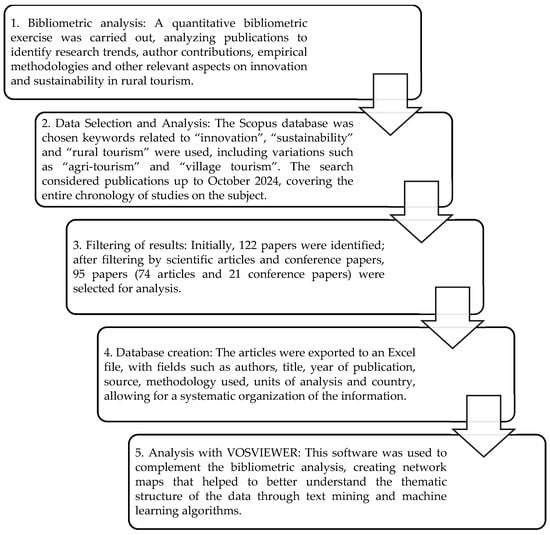
Figure 1.
Diagram showing the methodology used. Source: Own elaboration.
4. Bibliometric Analysis of Sustainability and Innovation in Rural Tourism
4.1. The Evolution of Studies
The focus on sustainability and innovation in rural tourism began to gain a more consistent presence in literature (although still limited) after 2010. Between 2010 and 2014, the number of papers remained minimal, with a noticeable increase in publications occurring after this period (Figure 2).
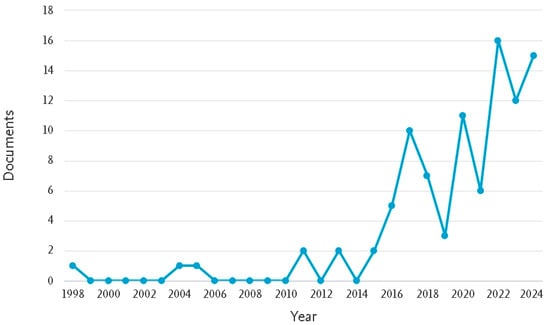
Figure 2.
Weight of sustainability and innovation in rural tourism. Source: Own elaboration based on data from Scopus.
More than half of the articles (64%) were published in the last five years. Indisputably, this trend reflects growing recognition of the importance of innovation and sustainability in rural tourism, as highlighted by various authors [3,56,57,58].
4.2. Documents by Authors and Affiliations
It is surprising to note that among 310 authors who are involved in publishing concerning innovation and sustainability in rural tourism-related topics, only four have two papers and all the others have only one paper. See Table 1.

Table 1.
Main contributors in innovation and sustainability.
Three of these authors are affiliated with universities in Italy, while the other is associated with Meiho University in Taiwan. Given the dispersion of authors in this field, it appears that innovation and sustainability in rural tourism have not yet become a primary focus of research. Regardless of the number of studies on this subject, there remains a notable lack of depth in the research on this subject.
This observation is further reinforced by the fact that, among 160 affiliations, only nine are associated with more than one publication (see Figure 3).
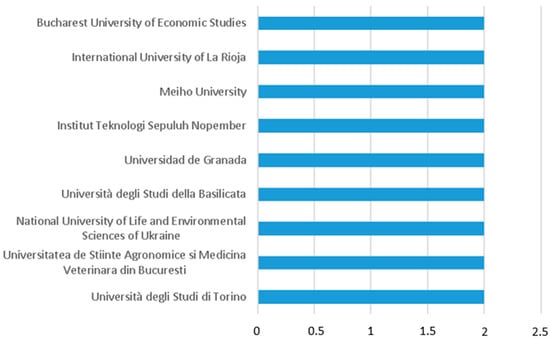
Figure 3.
Affiliations of authors. Source: Own elaboration based on data from Scopus.
Among these nine affiliations, seven belong to institutions located in Europe. The European Union has been a key supporter of rural tourism innovation through funding programs like the European Agricultural Fund for Rural Development (EAFRD) and the initiative “Links between activities for the development of rural economy” (LEADER). These initiatives also provide resources for developing sustainable tourism practices and encourage collaboration between local governments, businesses, and communities. The Green Deal and Farm to Fork strategies also emphasize sustainability in tourism by promoting greener practices in agriculture, energy use, and waste management within rural tourism ventures [59].
4.3. Relationship Between Authorss
In terms of relationships among authors out of the total number of authors (310) in the sample, only nine have relationships between each other. They are Blešić, Ivana; Demirović Bajrami, Dunja; Dubover, Denis A.; Gajić, Tamara; Penić, Mirjana; petrović, marko D.; Radovanović, Milan M.; Sekulić, Dejan; and Spasojević, Ana (see Figure 4).
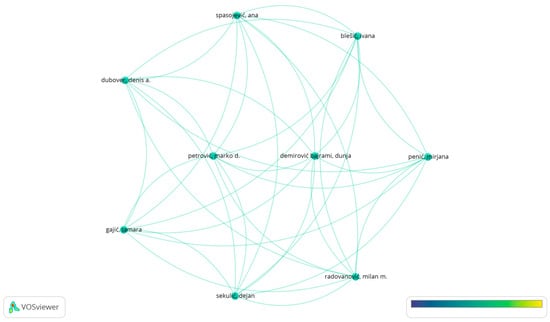
Figure 4.
Relationship between authors. Source: Own elaboration based on data from Scopus.
Except for one author (Dubover, D.A.), all these others are from universities or higher education institutions from Serbia. Since each of them has only one paper, despite this connection, this also reveals the dispersion of the research concerning innovation and sustainability.
4.4. Co-Citations Network
Out of 4658 references in total of the 94 articles, only three references are cited five times. They are the works of Broccardo et al. [59], Roman et al. [60] and Roberts and Hall [61]. Six references are cited four times and 14 references are cited three times (see Figure 5).
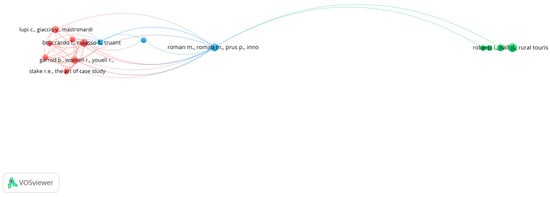
Figure 5.
Visualized co-citation network. Source: Own elaboration based on data from Scopus.
This finding corroborates previous data, revealing the dispersion of the research concerning innovation and sustainability in rural tourism.
4.5. Major Keywords Used by Research and Outlets of Publication
Of 351 keywords used in these 94 articles, 13 appeared at least three times in the list of keywords. The word most used was indeed “rural tourism”, which has 31 occurrences in those articles. This is followed by the words agritourism (15 occurrences), innovation (15 occurrences) and sustainability (nine occurrences). The weight of these words can be observed in Figure 6. The map shown in the mentioned figure is associated with three clusters. These clusters correspond to a specific theme or subtopic within the dataset.
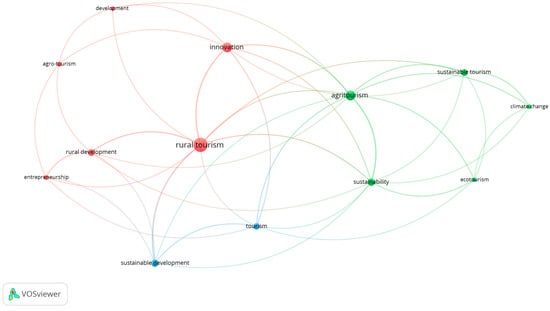
Figure 6.
VOSviewer keywords map. Source: Own elaboration based on data from Scopus.
Cluster 1: “Entrepreneurship in rural tourism” includes keywords such as entrepreneurship, innovation, rural tourism, agro-tourism, development, and rural development. As referred to by several authors ([3,57,58]), to foster rural development, entrepreneurship in rural tourism related products is essential. Moreover, the development of rural tourism areas needs substantial commitment on the part of family ventures and tourism entrepreneurs [41]. Innovation is a central aspect of entrepreneurship [24,25]. In essence, innovation in rural tourism can transform underdeveloped regions into attractive tourist destinations, while fostering economic growth, sustainability, and cultural preservation [62]. This is even more important in the presence of scarce human and financial resources, typical of rural areas [4], as mentioned before. In the case of rural tourism, it can be associated with the development and implementation of new ideas, practices, services, or products that enhance tourism experience.
Cluster 2: “Sustainable rural tourism” is composed of the keywords agritourism, ecotourism, climate change, sustainability, and sustainable tourism. As also referred to before, the number of studies linking rural tourism and sustainability has grown, as several authors recognize the importance of this connection [44,46,47]. Indeed, agritourism activities, as a particular type of rural tourism, are immediately associated with more sustainable tourism activities, and at the same time, they also contribute to the sustainability of tourism. The search for more sustainable experiences in rural areas reflects growing interest in eco-friendly tourism, regenerative agriculture, and community-based initiatives that preserve nature while benefiting local economies. There are several ways this trend manifests, each providing opportunities to experience rural life with a focus on sustainability. In addition to the economic and socio-cultural dimensions of sustainability, rural tourism in a broader sense, and agritourism in particular, as referred to by Santos et al. [3], reflects a tourism sector closely linked to environmental aspects.
Finally, Cluster 3: “Sustainable development of tourism” is made up of the keywords “sustainable development” and “tourism”. It reflects the attention paid to new sustainable forms of tourism development, such as agrotourism and rural tourism. The link between sustainability and rural/agrotourism is mentioned by Lane [14].
The publications with the highest number of articles published on innovation and sustainability in rural tourism are published in Sustainability Journal (with 16 articles), the Journal of Sustainable Tourism (with three articles) and the Tourism and Hospitality Journal (with two articles). All the other papers are published at conferences or in different journals. This certainly reflects the diversity of journals published in this field.
4.6. Main Countries Under Analysis
Most studies on innovation and sustainability in rural tourism focus on countries with high human development or high human development. In fact, out of a list of 22 countries (see Figure 7) where at least two articles’ research focuses on them, 68% of publications focus on very high human development countries and 27% on high human development countries. At the top of the ranking are China (with 14 articles), Indonesia (with 12 articles), Italy (with 12 articles) and Spain (with nine articles). These last two countries rank among the world’s greenest nations according to the Environmental Performance Index (EPI), which may explain the strong academic focus on sustainable rural tourism in those contexts [63].
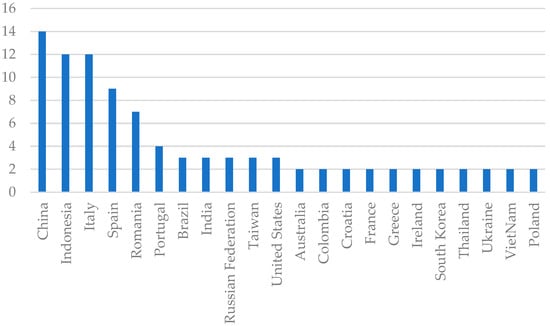
Figure 7.
Countries under research. Source: Own elaboration based on data from Scopus.
Since rural tourism is important in the tourism context of these countries [1], it is to be expected that they will increasingly adopt specific measures to improve innovation and sustainability in their economy and, by extension, in tourism and rural tourism. Countries that invest heavily in innovation and sustainability are usually those with advanced economies and strong commitments to environmental protection, green energy and technological research, which helps explain the prominence of Europe in our findings.
4.7. Main Empirical Methodologies Used
In terms of empirical methodologies used, the bulk of the articles are empirical (78%). Regarding the empirical methodologies used in innovation and sustainability-related papers, it is apparent that qualitative methods have been favoured over time, accounting for 59% of the total published works (see Figure 8).
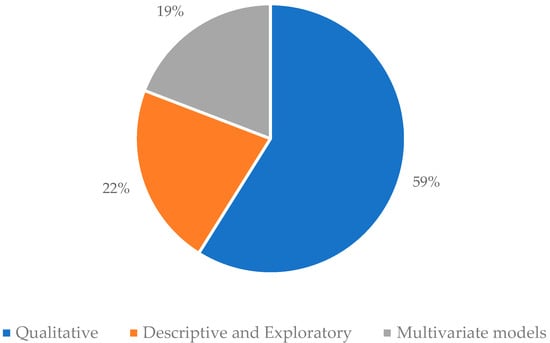
Figure 8.
Empirical methodologies used. Source: Own elaboration based on data from Scopus.
As a field of research that is often associated with rural areas and where the advances in technology are missing (due to the natural conditions of many of these spaces), qualitative analyses tend to be the ‘natural’ way of producing science, which may then lead to ‘generalised theorization’ [25].
5. Conclusions
The literature review highlights the importance of innovation and sustainability in rural tourism, emphasizing that both are essential for the sustainable development of these areas [64]. Although the presumption that innovation breeds sustainability, innovations also should create positive economic, social, and environmental outcomes. By integrating innovation into rural tourism, destinations can achieve a balance between economic benefits and environmental responsibility, ensuring long-term sustainability.
Innovation is analyzed from Schumpeter’s perspective and expanded with modern concepts, including organizational, product and marketing innovations. While sustainability is explored in terms of environmental preservation, cultural valorization and socio-economic benefits for local communities. This theoretical basis is used to justify the relevance of a detailed bibliometric study, combining the two interrelated concepts.
The results of the study, obtained through a bibliometric analysis of 94 articles from 310 authors in the Scopus database and considering the period until the moment of the search (8 October 2024), can serve as a strategic guide for researchers, policymakers and entrepreneurs in the sector, supporting evidence-based decision-making. It has sought to understand the evolution of the existing literature on sustainable and innovative rural tourism, it has identified the most influential research centers that can promote future collaborations, and it has identified approaches and trends that are shaping the future of sustainable rural tourism.
Some of the conclusions drawn from this study are as follows: (1) despite the growing relevance of the themes of innovation and sustainability, there is still thematic dispersion and a lack of depth in relation to the integration of these dimensions in rural tourism; (2) the geographical scope of existing research is narrow, predominantly focused on countries with high human development, leaving a gap in less developed regions where innovation and sustainability could be even more impactful; (3) the concentration of publications occurred in the last 10 years, with a prominence of the Sustainability Journal; (4) it is possible to identify some methodological gaps, since there is a predominance of qualitative methods, but little emphasis on quantitative methods of analysis, particularly multivariate methods; finally, (5) the concept addressed in the literature review of “innovation through tradition” (ITT) is especially relevant to rural tourism, suggesting that innovative practices should respect and value the cultural and historical aspects of rural areas.
Overall, our analysis suggests that innovation and sustainability are mutually reinforcing in the rural tourism context. For example, introducing innovative solutions—such as renewable energy systems in rural accommodations or digital platforms to promote local heritage—can enhance the environmental and socio-economic sustainability of rural tourism by reducing ecological impacts and engaging local communities. Conversely, striving for sustainability often drives innovation, as seen in creative initiatives like water-saving irrigation for agritourism farms or novel waste-recycling methods tailored to remote rural areas. This synergy implies that improvements in one dimension (e.g., sustainability) facilitate progress in the other (innovation), leading to more resilient and competitive rural tourism ventures. Conceptual frameworks in the literature support this interplay; for instance, the ‘innovation through tradition’ (ITT) approach shows how leveraging traditional knowledge in new ways yields sustainable outcomes by preserving cultural heritage while enhancing the tourist experience. Despite these intrinsic connections, our bibliometric review revealed that academic studies rarely address innovation and sustainability in an integrated manner, highlighting the need for more research on their combined implementation in rural tourism.
As suggested by Santos et al. [3] related to tourism in general, we agree that the indicators of innovation and sustainability still need to be better understood in terms of their association with the rural tourism context. It is essential to rethink a more integrated approach to innovative and sustainable rural tourism, which would lead to a powerful mechanism of rural development.
This work has some limitations, particularly in the methodology used. The bibliometric exercise carried out was based only on articles and conference papers published in journals indexed in Scopus, thus excluding (valid) scientific production published in other types of publications, namely books and book chapters. Furthermore, relying solely on Scopus-indexed publications may introduce a geographical bias, as research from certain regions and non-English publications can be underrepresented in such databases. Moreover, the analysis focuses primarily on (very) high human development countries, limiting the applicability of findings to diverse rural contexts globally.
Therefore, in terms of future research, we suggest deepening this study by comparing trends in innovation and sustainability in rural tourism between different regions and/or countries, extending the investigation of innovation and sustainability in rural tourism to other regions and/or countries, particularly in countries with medium human development and low human development; exploring the categories and/or dimensions of innovation and sustainability in rural tourism; and investigating the role of emerging technologies (AI, IoT, blockchain) as tools to help sustainable management of rural tourism and innovation in the sector. Finally, we believe it would also be pertinent to develop a study on how rural tourism can contribute to mitigating climate change, for example by assessing the resilience of rural destinations in the face of extreme weather events.
Author Contributions
Conceptualization, M.L.P.; methodology, M.L.P.; results (collecting data, analysis and interpretation), M.L.P. and A.S.D.; discussion, M.L.P. and A.S.D.; conclusions, M.L.P. and A.S.D. All authors have read and agreed to the published version of the manuscript.
Funding
This research received no external funding.
Institutional Review Board Statement
Not applicable.
Informed Consent Statement
Not applicable.
Data Availability Statement
The original data presented in the study are openly available in Scopus Preview database at [www.scopus.com/home.uri].
Acknowledgments
This work is funded by National Funds through the FCT—Foundation for Science and Technology, I.P., within the scope of the project Refª UIDB/00681/2020. Furthermore, we would like to thank the CERNAS Research Centre and the Polytechnic Institute of Viseu for their support. Moreover, the authors would like to thank the support from the Centre of Studies in Geography and Spatial Planning (CEGOT), funded by national funds through the Foundation for Science and Technology (FCT) under the reference UIDB/04084/2025.
Conflicts of Interest
The authors declare no conflicts of interest.
References
- Šajn, N.; Finer, K. Rural tourism. European Parliamentary Research Service. Available online: www.europarl.europa.eu/RegData/etudes/BRIE/2023/751464/EPRS_BRI(2023)751464_EN.pdf (accessed on 9 November 2024).
- UNWTO. Rural Tourism. Available online: https://www.unwto.org/rural-tourism (accessed on 9 November 2024).
- Santos, V.; Sousa, M.J.; Costa, C.; Au-Yong-Oliveira, M. Tourism towards sustainability and innovation: A systematic literature review. Sustainability 2021, 13, 11440. [Google Scholar] [CrossRef]
- Pato, M.L.; Kastenholz, E. Marketing of rural tourism—A study based on rural tourism lodgings in Portugal. J. Place Manag. Dev. 2017, 10, 121–139. [Google Scholar] [CrossRef]
- Rodrigues, A.O.A.; Marques, C.S.; Ramadani, V. Artisan entrepreneurship, resilience and sustainable development: The quintuple helix innovation model in the low-density and cross-border territories. J. Enterp. Inf. Manag. 2023, 37, 1603–1626. [Google Scholar] [CrossRef]
- Azmi, E.; Che Rose, R.A.; Awang, A.; Abas, A. Innovative and Competitive: A Systematic Literature Review on New Tourism Destinations and Products for Tourism Supply. Sustainability 2023, 15, 1187. [Google Scholar] [CrossRef]
- Antunes, M.; Dias, Á.; Gonçalves, F.; Sousa, B.; Pereira, L. Measuring Sustainable Tourism Lifestyle Entrepreneurship Orientation to Improve Tourist Experience. Sustainability 2023, 15, 1201. [Google Scholar] [CrossRef]
- Figueras, C.N.; Prados, F.J.C.; Sayago, P.E. 30 years of LEADER in Andalusia, Southern Spain. Diversification, rural tourism and smart growth. Investig. Geogr. 2022, 78, 239–258. [Google Scholar]
- Zanetti, B.; Verrascina, M.; Licciardo, F.; Gargano, G. Agritourism and Farms Diversification in Italy: What Have We Learnt from COVID-19? Land 2022, 11, 1215. [Google Scholar] [CrossRef]
- Rosalina, P.D.; Dupre, K.; Wang, Y. Rural tourism: A systematic literature review on definitions and challenges. J. Hosp. Tour. Manag. 2021, 47, 134–149. [Google Scholar] [CrossRef]
- Guan, J.; Gao, J.; Zhang, C. Food heritagization and sustainable rural tourism destination: The case of China’s Yuanjia village. Sustainability 2019, 11, 2858. [Google Scholar] [CrossRef]
- Kastenholz, E.; Carneiro, M.J.; Marques, C.; Lima, J. Understanding and managing the rural tourism experience—The case of a historical village in Portugal. Tour. Manag. Perspect. 2012, 4, 207–214. [Google Scholar] [CrossRef]
- Sousa, A.J.G.; Kastenholz, E. Wind farms and the rural tourism experience—Problem or possible productive integration? The views of visitors and residents of a Portuguese village. Rural Tour. 2018, 104–124. [Google Scholar]
- Lane, B. What is rural tourism? J. Sustain. Tour. 1994, 2, 7–21. [Google Scholar] [CrossRef]
- Feng, N.; Wei, F.; Zhang, K.H.; Gu, D. Innovating Rural Tourism Targeting Poverty Alleviation through a Multi-Industries Integration Network: The Case of Zhuanshui Village, Anhui Province, China. Sustainability 2018, 10, 2162. [Google Scholar] [CrossRef]
- Frochot, I. A benefit segmentation of tourists in rural areas: A Scottish perspective. Tour. Manag. 2005, 26, 335–346. [Google Scholar] [CrossRef]
- Sharpley, R. Rural Tourism: An Introduction; Thomson Learning: London, UK, 1997. [Google Scholar]
- Sharpley, R.; Roberts, L. Rural tourism—10 years on. Int. J. Tour. Res. 2004, 6, 119–124. [Google Scholar] [CrossRef]
- Hernández Maestro, R.M.; Muñoz Gallego, P.A.; Santos Requejo, L. The moderating role of familiarity in rural tourism in Spain. Tour. Manag. 2007, 28, 951–964. [Google Scholar] [CrossRef]
- Pina, I.P.A.; Delfa, M.T.D. Rural tourism demand by type of accommodation. Tour. Manag. 2005, 26, 951–959. [Google Scholar] [CrossRef]
- Pato, M.L. A decade of olive oil tourism: A bibliometric survey. Sustainability 2024, 16, 1665. [Google Scholar] [CrossRef]
- Ribeiro, M.; Marques, C. Rural tourism and the development of less favoured areas—Between rhetoric and practice. Int. J. Tour. Res. 2002, 4, 211–220. [Google Scholar] [CrossRef]
- Lane, B.; Kastenholz, E. Rural Tourism: The Evolution of Practice and Research Approaches–Towards a New Generation Concept? J. Sustain. Tour. 2015, 23, 1133–1156. [Google Scholar] [CrossRef]
- Schumpeter, J.A.; Swedberg, R. The Theory of Economic Development; Routledge: London, UK, 2021. [Google Scholar]
- Pato, M.L.; Teixeira, A.A.C. Twenty Years of Rural Entrepreneurship: A Bibliometric Survey. Sociol. Rural. 2016, 56, 3–28. [Google Scholar] [CrossRef]
- Pato, M.L. Entrepreneurship and Innovation Towards Rural Development: Evidence from a Peripheral Area in Portugal. Eur. Countrys 2020, 12, 209–220. [Google Scholar] [CrossRef]
- OECD; Eurostat. Oslo Manual—Guidelines for Collecting and Interpreting Innovation Data; OECD and Eurostat: Paris, France, 2005. [Google Scholar]
- OECD; Eurostat. Guidelines for Collecting, Reporting, and Using Data on Innovation: The Measurement of Scientific, Technological and Innovation Activities; OECD and Eurostat: Luxembourg; Paris, France, 2018. [Google Scholar]
- Capaldo, A.; Petruzzelli, A.M. Partner Geographic and Organizational Proximity and the Innovative Performance of Knowledge-Creating Alliances. Eur. Manag. Rev. 2014, 11, 63–84. [Google Scholar] [CrossRef]
- Messeni Petruzzelli, A.; Savino, T. Reinterpreting Tradition to Innovate: The Case of Italian Haute Cuisine. Ind. Innov. 2015, 22, 677–702. [Google Scholar] [CrossRef]
- Wang, W.; Ding, L.; Chan, J.H.; Qi, X. Process Framework for Innovation through Tradition and Its Antecedents in Rural Heritage B&B. Int. J. Contemp. Hosp. Manag. 2022, 34, 4329–4354. [Google Scholar] [CrossRef]
- Pato, M.L. Olive Oil Tourism: Innovative or Traditional Form of Rural Tourism? In Olives and Olive Related Products—Innovations in Production and Processing; Lagouri, V., Grichar, W.J., Eds.; IntechOpen: Rijeka, Croatia, 2025. [Google Scholar]
- Presenza, A.; Petruzzelli, A.M.; Sheehan, L. Innovation through Tradition in Hospitality: The Italian Case of Albergo Diffuso. Tour. Manag. 2019, 72, 192–201. [Google Scholar] [CrossRef]
- De Massis, A.; Frattini, F.; Kotlar, J.; Petruzzelli, A.M.; Wright, M. Innovation through Tradition: Lessons from Innovative Family Businesses and Directions for Future Research. Acad. Manag. Perspect. 2016, 30, 93–116. [Google Scholar] [CrossRef]
- Bezerra, R.; Correia, A.I. The potential of olive oil for creative tourism experiences in the northern region of Portugal. Rev. Port. Estud. Reg. 2019, 51, 55–72. [Google Scholar] [CrossRef]
- Madanaguli, A.; Kaur, P.; Mazzoleni, A.; Dhir, A. The Innovation Ecosystem in Rural Tourism and Hospitality—A Systematic Review of Innovation in Rural Tourism. J. Knowl. Manag. 2022, 26, 1732–1762. [Google Scholar] [CrossRef]
- Hjalager, A.-M.; Kwiatkowski, G.; Østervig Larsen, M. Innovation gaps in Scandinavian rural tourism. Scand. J. Hosp. Tour. 2018, 18, 1–17. [Google Scholar] [CrossRef]
- Gössling, S.; Lane, B. Rural tourism and the development of Internet-based accommodation booking platforms: A study in the advantages, dangers and implications of innovation. J. Sustain. Tour. 2015, 23, 1386–1403. [Google Scholar] [CrossRef]
- Romeiro, P.; Costa, C. The potential of management networks in the innovation and competitiveness of rural tourism: A case study on the Valle del Jerte (Spain). Curr. Issues Tour. 2010, 13, 75–91. [Google Scholar] [CrossRef]
- UNWTO. Sustainable Development. s.d. Available online: https://www.unwto.org/sustainable-development (accessed on 9 November 2024).
- Utami, D.D.; Dhewanto, W.; Lestari, Y.D. Rural Tourism Entrepreneurship Success Factors for Sustainable Tourism Village: Evidence from Indonesia. Cogent Bus. Manag. 2023, 10, 2180845. [Google Scholar] [CrossRef]
- Ivona, A. Sustainability of Rural Tourism and Promotion of Local Development. Sustainability 2021, 13, 8854. [Google Scholar] [CrossRef]
- Popescu, G.; Popescu, C.A.; Iancu, T.; Brad, I.; Peț, E.; Adamov, T.; Ciolac, R. Sustainability through Rural Tourism in Moieciu Area-Development Analysis and Future Proposals. Sustainability 2022, 14, 4221. [Google Scholar] [CrossRef]
- Mwesiumo, D.; Halfdanarson, J.; Shlopak, M. Navigating the Early Stages of a Large Sustainability-Oriented Rural Tourism Development Project: Lessons from Traena, Norway. Tour. Manag. 2022, 89, 104445. [Google Scholar] [CrossRef]
- Cunha, C.; Kastenholz, E.; Carneiro, M.J. Entrepreneurs in Rural Tourism: Do Lifestyle Motivations Contribute to Management Practices That Enhance Sustainable Entrepreneurial Ecosystems? J. Hosp. Tour. Manag. 2020, 44, 215–226. [Google Scholar] [CrossRef]
- Kallmuenzer, A.; Nikolakis, W.; Peters, M.; Zanon, J. Trade-Offs between Dimensions of Sustainability: Exploratory Evidence from Family Firms in Rural Tourism Regions. J. Sustain. Tour. 2018, 26, 1204–1221. [Google Scholar] [CrossRef]
- An, W.; Alarcón, S. How Can Rural Tourism Be Sustainable? A Systematic Review. Sustainability 2020, 12, 7758. [Google Scholar] [CrossRef]
- Ćurčić, N.; Mirković Svitlica, A.; Brankov, J.; Bjeljac, Ž.; Pavlović, S.; Jandžiković, B. The Role of Rural Tourism in Strengthening the Sustainability of Rural Areas: The Case of Zlakusa Village. Sustainability 2021, 13, 6747. [Google Scholar] [CrossRef]
- Cruz, S.C.; Teixeira, A.A. The Evolution of the Cluster Literature: Shedding Light on the Regional Studies–Regional Science Debate. Reg. Stud. 2010, 44, 1263–1288. [Google Scholar] [CrossRef]
- McElwee, G.; Atherton, A. Publication Trends and Patterns in Entrepreneurship: The Case of the International Journal of Entrepreneurship and Innovation. J. Small Bus. Enterp. Dev. 2005, 12, 92–103. [Google Scholar] [CrossRef]
- Aria, M.; Cuccurullo, C. bibliometrix: An R-Tool for Comprehensive Science Mapping Analysis. J. Informetr. 2017, 11, 959–975. [Google Scholar] [CrossRef]
- Baas, J.; Schotten, M.; Plume, A.; Côté, G.; Karimi, R. Scopus as a Curated, High-Quality Bibliometric Data Source for Academic Research in Quantitative Science Studies. Quant. Sci. Stud. 2020, 1, 377–386. [Google Scholar] [CrossRef]
- Pan, X.; Yan, E.; Cui, M.; Hua, W. Examining the usage, citation, and diffusion patterns of bibliometric mapping software: A comparative study of three tools. J. Informetr. 2018, 12, 481–493. [Google Scholar] [CrossRef]
- Moral-Muñoz, J.A.; Herrera-Viedma, E.; Santisteban-Espejo, A.; Cobo, M.J. Software tools for conducting bibliometric analysis in science: An up-to-date review. Prof. Inf. 2020, 29. [Google Scholar] [CrossRef]
- Eck, N.J.V.; Waltman, L. VOSviewer Manual; Universiteit Leiden: Leiden, The Netherlands, 2023; Available online: www.vosviewer.com/documentation/Manual_VOSviewer_1.6.18.pdf (accessed on 2 January 2025).
- Palmi, P.; Lezzi, G.E. How authenticity and tradition shift into sustainability and innovation: Evidence from Italian agritourism. Int. J. Environ. Res. Public Health 2020, 17, 5389. [Google Scholar] [CrossRef]
- Dias, Á.; Silva, G.M. Lifestyle Entrepreneurship and Innovation in Rural Areas: The Case of Tourism Entrepreneurs. J. Small Bus. Strateg. 2021, 31, 40–49. [Google Scholar] [CrossRef]
- Sarabia-Molina, M.Y.; Soares, J.R.R.; Lois-González, R.C. Innovations in Community-Based Tourism: Social Responsibility Actions in the Rural Tourism in the Province of Santa Elena–Ecuador. Sustainability 2022, 14, 13589. [Google Scholar] [CrossRef]
- Broccardo, L.; Culasso, F.; Truant, E. Unlocking value creation using an agritourism business model. Sustainability 2017, 9, 1618. [Google Scholar] [CrossRef]
- Roman, M.; Roman, M.; Prus, P. Innovations in agritourism: Evidence from a region in Poland. Sustainability 2020, 12, 4858. [Google Scholar] [CrossRef]
- Roberts, L.; Hall, D. Rural Tourism and Recreation: Principles to Practice; CABI: New York, NY, USA, 2001. [Google Scholar]
- Lordkipanidze, M.; Brezet, H.; Backman, M. The Entrepreneurship Factor in Sustainable Tourism Development. J. Clean. Prod. 2005, 13, 787–798. [Google Scholar] [CrossRef]
- EPI. Environmental Performance Index; Yale Center for Environmental Law & Policy: New Haven, CT, USA, 2024. [Google Scholar]
- Pato, L.; Leguíssimo, M. The Role of Innovation and Sustainability in Tourism Lodgings in Douro Region, Portugal. Rev. Tur. Desenv. 2024, 46. [Google Scholar] [CrossRef]
Disclaimer/Publisher’s Note: The statements, opinions and data contained in all publications are solely those of the individual author(s) and contributor(s) and not of MDPI and/or the editor(s). MDPI and/or the editor(s) disclaim responsibility for any injury to people or property resulting from any ideas, methods, instructions or products referred to in the content. |
© 2025 by the authors. Licensee MDPI, Basel, Switzerland. This article is an open access article distributed under the terms and conditions of the Creative Commons Attribution (CC BY) license (https://creativecommons.org/licenses/by/4.0/).